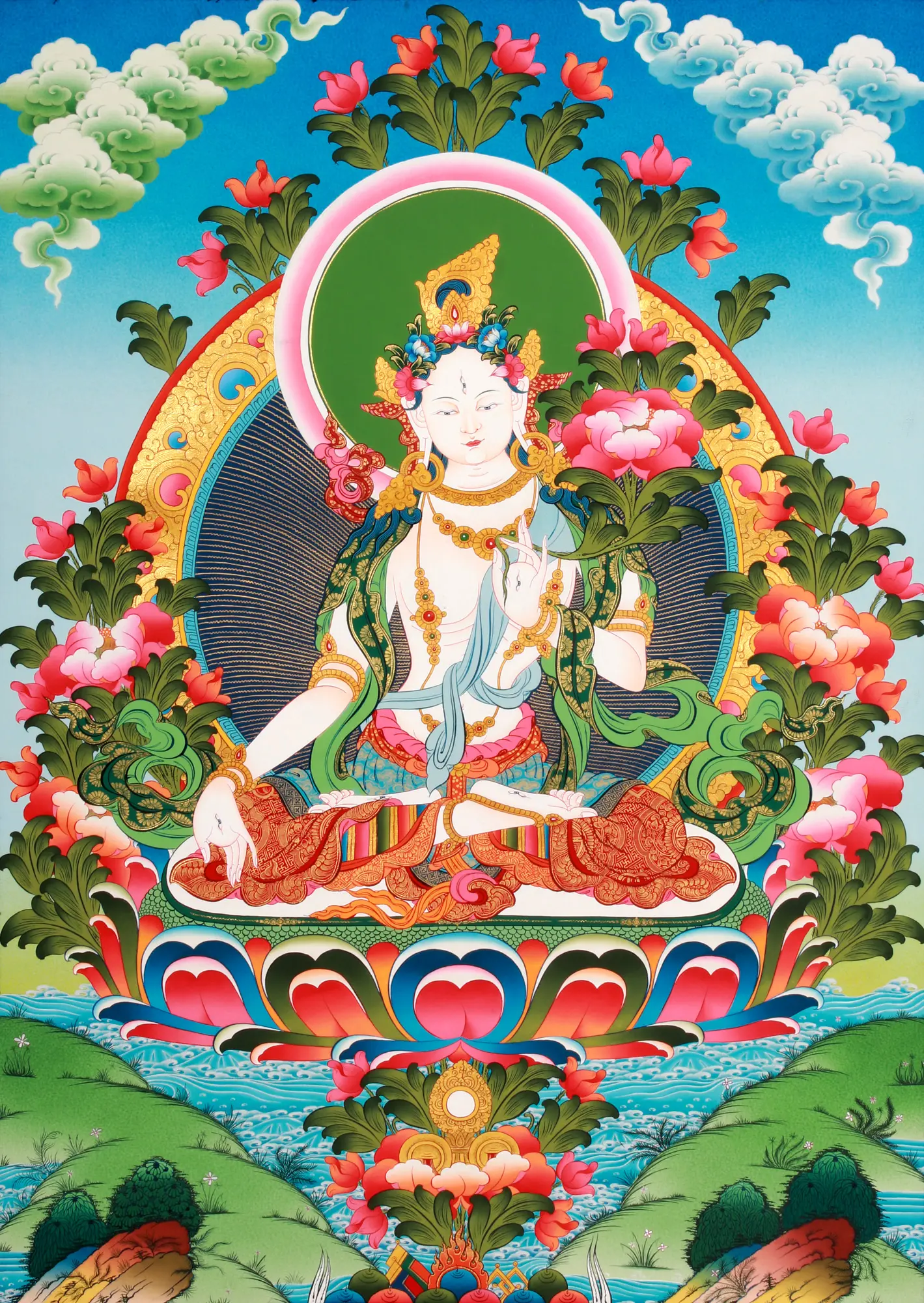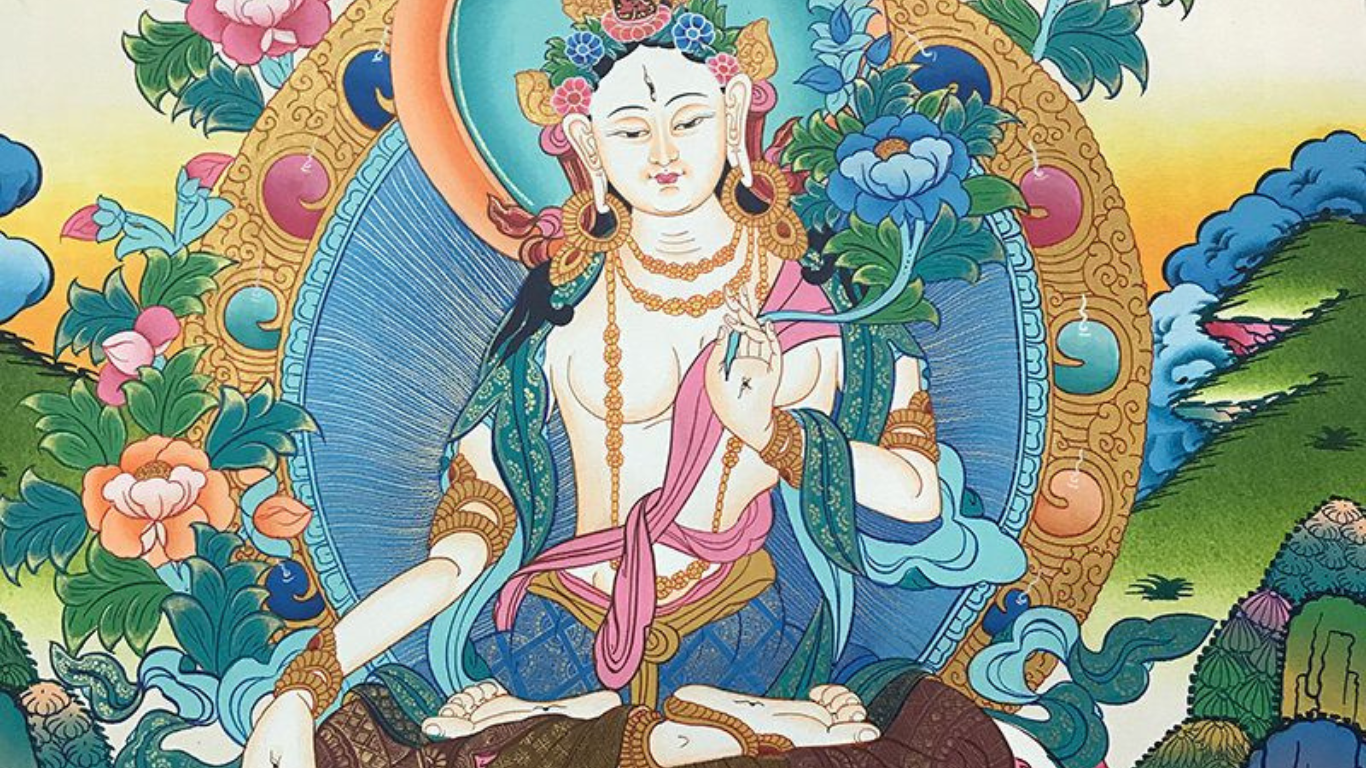According to Buddhist tradition, Tara’s origins trace back to the tears of compassion shed by the bodhisattva Avalokiteshvara. Legend holds that as Avalokiteshvara gazed upon the suffering world, his tears formed a lake from which a lotus emerged, revealing the goddess Tara. White Tara, in particular, is said to have arisen from the tears of Avalokiteshvara’s left eye, embodying the motherly aspect of compassion.
In Vajrayana Buddhism, White Tara is revered as the Mother of all Buddhas, symbolizing purity, wisdom, and truth through her white color. Her practice is believed to aid practitioners in overcoming obstacles and gaining wisdom. Unlike Green Tara, White Tara is depicted with both legs folded in a meditation posture, known as the Full-Vajra posture, representing her serene and meditative nature.
White Tara is renowned for her swiftness in granting wishes, bestowing happiness, and extending longevity. Devotees seek her blessings to develop wisdom and lead fulfilling lives. Her compassionate presence is believed to bring solace, protection, and guidance to those who invoke her aid, embodying the nurturing and nurturing aspect of enlightened compassion.
White Tara Depiction in Buddhist Art
White Tara is typically depicted in Buddhist art with a serene and gentle countenance, radiating compassion and wisdom. Adorned with elegant garments and adorned with divine ornaments, she sits gracefully in a meditative posture, with both legs folded in the Full-Vajra position, symbolizing her serene and tranquil nature. White Tara’s right hand is often shown in the gesture of granting blessings, while her left hand holds a white lotus flower, representing purity and enlightenment. Her eyes, filled with compassion, gaze benevolently upon all sentient beings, offering solace and guidance to those who seek her aid. This depiction of White Tara embodies her role as the Mother of all Buddhas, emanating purity, wisdom, and boundless compassion to alleviate the suffering of the world.

White Tara Mantra
White Tara (Sitatara) is associated with longevity. Her mantra is often chanted with a particular person in mind. She’s another representation of compassion, and she’s pictured as being endowed with seven eyes (the palms of the hands, soles of the feet, and her forehead) to symbolize the watchfulness of the compassionate mind.
Om Tare Tuttare Ture Mama Ayuh Punya Jñana Pustim Kuru Svaha
As a variant form of Green Tara, her mantra begins very similarly. But there are several words added that connects White Tara with long life and wellbeing.
Om: It has to do with the body, the mind, and the approach to universal divinity.
Tare: It’s the liberation of the sufferings, feelings, and inferior strength.
Tuttare: It represents protection against internal and external dangers.
Ture: It’s a protection against physical diseases and a peace-generating word.
Mama: “mine” and indicates that you’d like to possess these qualities of long life, merit, wisdom, and happiness. You can also wish these qualities for someone else, and contemplate the White Tara practice to that person.
Ayuh: long life (as in Ayurvedic medicine).
Punya: the merit that comes from living life ethically, and this merit is said to help one to live long and happily.
Jnana: wisdom.
Pushtim: wealth, abundance, or increase.
Kuru: a mythical land to the north of the Himalayas, which was said to be a land of long life and happiness.
Svaha: an exclamation meaning “hail” or “may blessings be upon” and is a common ending to Buddhist mantras.
Tara is very close to sentient beings, like a mother to her children. She is very quick to fulfill our wishes and to grant us happiness and a long life, as well as to help us develop wisdom. By taking refuge in Tara and practicing meditation, visualizations, and having faith, you have the power to remove obstacles to your life and to prolong your life.



